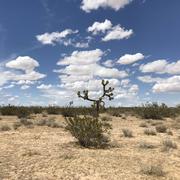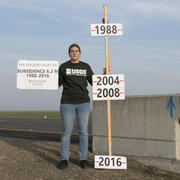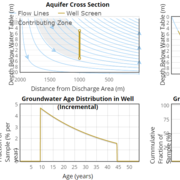California Water Science Center
Groundwater
Browse Groundwater science related to:
Sustainable Groundwater Management
In 2014, the State of California adopted historic legislation to help manage its groundwater, the Sustainable Groundwater Management Act (SGMA) . According to the act, local Groundwater Sustainability Agencies (GSAs) must be formed for all...
Hydrogeological Evaluation of the Edwards Air Force Base Air Force Research Laboratory Area and the North Muroc Groundwater Subbasin, Antelope Valley, California
In cooperation with Air Force Civil Engineer Center (AFCEC), the U.S. Geological Survey (USGS) is evaluating the hydrogeology of the Air Force Research Laboratory (AFRL) and Site 25 areas of Edwards Air Force Base (EAFB) and the adjacent North-Muroc groundwater subbasin to help determine regional groundwater movement and the possible long-term movement and pathways of contaminated...
Evaluation of Groundwater Resources in the Adelaida Area of San Luis Obispo County, California
Stakeholders in San Luis Obispo County are concerned that the increased demand for water use has, and will continue to, affect groundwater levels and availability in the Adelaida area. To address stakeholder concerns, the County of San Luis Obispo Board of Supervisors has asked the USGS to conduct a comprehensive evaluation of groundwater resources of the Adelaida area.
Evaluation of groundwater resources of the Anza-Terwilliger area, Anza, California
Groundwater is the sole source for water use to the rural community and two Native American tribes in the Cahuilla Valley and Terwilliger Valley groundwater basins, which are located approximately 35 miles southwest of Palm Springs, California. The characteristics and sustainable yield of the basins are not well understood and are threatened by increasing water use and potential changes in...
Land Subsidence in California
Extensive groundwater withdrawals from aquifer systems have caused land subsidence in many California basins. Land subsidence can cause infrastructure damage, not only to buildings and roads but also to water conveyence systems. Groundwater-level and land-subsidence monitoring provide the information needed to guide mitigation efforts and management of future effects.
San Diego Hydrogeology
This is the first comprehensive geologic and hydrologic study for the San Diego area. This study will provide the integrated hydrogeologic knowledge necessary in this important and highly visible area of the United States and will serve as a role model for similar coastal settings throughout the world that have modest rainfall and small aquifers. Locally, results will help...
Groundwater Ambient Monitoring & Assessment (GAMA)
The Groundwater Ambient Monitoring and Assessment Program’s Priority Basin Project (GAMA-PBP) was established by the California State Water Resources Control Board (SWRCB) in response to the Ground-Water Quality Monitoring Act of 2001 (Sections 10780-10782.3 of the California Water Code). The USGS is the technical lead for the GAMA-PBP and between 2004-2012 focused on characterizing the...
Occurrence of natural and anthropogenic hexavalent chromium (Cr VI) in groundwater near a mapped plume, Hinkley, CA
Between 1952 and 1964, cooling water was treated with a compound containing chromium to prevent corrosion within the Pacific Gas and Electric Company (PG&E) Hinkley Compressor Station. This water was discharged to unlined ponds, resulting in contamination of soil and groundwater within the underlying alluvial aquifer. The purpose of this study is to evaluate the occurrence of natural and...
Regional Groundwater Availability Study of the California Coastal Basins
This study seeks to quantify water availability in the California Coastal Basins (CCBs). The CCBs vary greatly in their geologic, hydrologic, and climatic conditions; predominant water uses (agricultural, urban, or environmental); and how water availability changes in response to natural and anthropogenic stresses. Considering the complex dynamics of the CCBs and the history of managing water...
Groundwater Age
The age of groundwater is key in predicting which contaminants it might contain. There are many tracers and techniques that allow us to estimate the age—or mix of ages—of the groundwater we depend on as a drinking water supply.
Salinas and Carmel River Basins Study
Together, the Salinas and Carmel river basins include some of the world’s most fertile agricultural lands and are internationally known for their natural beauty; ecological diversity; multi-national cultural history; and recreation opportunities such as fishing, auto racing, and golfing. The area is oftentimes referred to as the “Salad Bowl of the World” or “America’s Salad Bowl” because of...
Salinas and Carmel Rivers Basin Study: Paso Robles Model Update
The existing Paso Robles Basin Model (PRBM) needed to be updated and enhanced to achieve the timeline and objectives of the Salinas Carmel River Basin Study (SCRBS) for the U.S. Bureau of Reclamation (Reclamation) and local partners.
SGMApy: An open source platform for computing sustainability metrics and visualizing MODFLOW data
Climate change and demographic changes have underscored the need to improve effectiveness of managing valuable water resources for sustainability. In 2014, the Sustainable Groundwater Management Act (SGMA) established a framework for sustainable, local groundwater management. SGMA requires groundwater-dependent regions to halt overdraft and bring basins into balanced levels of pumping and...













